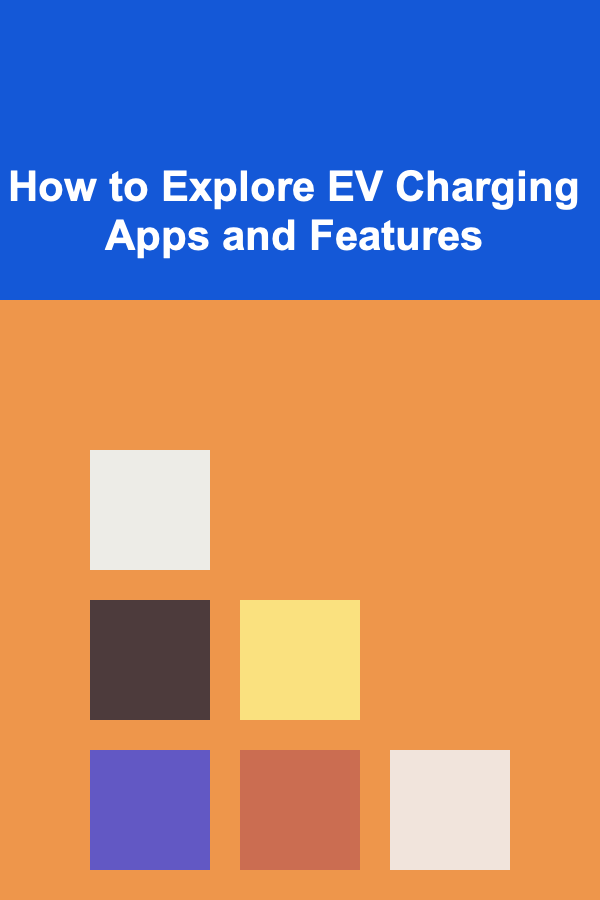
How to Explore EV Charging Apps and Features
ebook include PDF & Audio bundle (Micro Guide)
$12.99$6.99
Limited Time Offer! Order within the next:

Electric vehicles (EVs) have grown exponentially in popularity over the last few years, driven by the global shift towards sustainability and reduced dependence on fossil fuels. As a result, the EV market has witnessed a surge in innovation, with companies continuously developing new technologies and features to enhance the EV ownership experience. Among the most important of these innovations are EV charging apps, which serve as essential tools for drivers seeking to locate charging stations, monitor charging progress, and streamline their entire charging experience.
In this article, we will explore the world of EV charging apps and their features in-depth. We'll examine how these apps work, the various features they offer, and how to maximize their use to ensure a seamless EV charging experience. Whether you are an EV owner or someone considering making the switch to electric, this article will provide valuable insights into the rapidly evolving world of EV charging apps.
The Role of EV Charging Apps
EV charging apps are mobile applications designed to assist electric vehicle owners in locating, accessing, and paying for charging stations. These apps serve as a bridge between the driver and the ever-growing network of public charging stations. They aim to simplify the charging process, helping drivers find compatible stations, check availability, and even schedule charging sessions.
In many ways, EV charging apps play a crucial role in easing the transition to electric vehicles. While home charging is an option for many EV owners, public charging stations are an essential part of the charging infrastructure, particularly for long-distance travel or for those without access to home charging. As a result, charging apps have become indispensable tools for navigating the charging landscape, ensuring that EV owners can always stay charged and ready to hit the road.
Key Features of EV Charging Apps
There are numerous EV charging apps available, each offering a variety of features that cater to different user needs. Below are some of the key features commonly found in EV charging apps:
1. Charging Station Locator
One of the primary functions of any EV charging app is the ability to locate nearby charging stations. These apps utilize GPS technology to identify the user's location and provide a map of available charging stations within a certain radius. This feature is particularly useful when traveling in unfamiliar areas or when the nearest charging station is not immediately obvious.
The charging station locator typically includes the following information:
- Location: The precise address of the charging station.
- Types of Chargers: Different EV models require different types of chargers. Charging apps typically display the available charging options (e.g., Level 1, Level 2, or DC fast charging) to help drivers find the appropriate station for their needs.
- Availability: Many apps display real-time data on the availability of each charging station, helping drivers avoid wasting time searching for an open port.
- Station Amenities: Some apps also provide information about additional amenities near the charging stations, such as cafes, restrooms, and restaurants, which can make long charging sessions more comfortable.
2. Real-Time Charging Status
Monitoring the progress of a charging session is an essential feature in most EV charging apps. This feature allows users to track the status of their vehicle's charging, including the amount of energy being delivered, the current state of charge (SOC), and the estimated time remaining before the vehicle is fully charged.
Real-time charging status updates often include:
- Charging Speed: The app may display the rate at which the vehicle is being charged (e.g., in kilowatts per hour).
- Remaining Time: A countdown or estimation of how long it will take for the vehicle to reach full charge.
- Notifications: Many apps send push notifications to alert users when their charging session is complete or if there are any issues with the charging process.
3. Payment Integration
EV charging apps often integrate payment features, allowing users to pay for their charging sessions directly through the app. Payment methods may include credit/debit cards, mobile wallets, or even subscription services that offer discounted rates at participating stations.
In addition to the convenience of making payments through the app, users can also benefit from:
- Transparent Pricing: Charging apps typically display the cost per kWh (kilowatt-hour) or per session, allowing users to compare pricing across different stations.
- Discounts and Offers: Some apps provide special promotions, loyalty programs, or subscription-based models that offer discounted rates or access to exclusive charging networks.
- Billing History: Users can view their charging history and track the costs associated with each session. This feature is particularly useful for individuals who use their EVs for business purposes or need to manage their expenses efficiently.
4. Route Planning and Trip Assistance
For long-distance travelers, route planning is a critical feature that many EV charging apps offer. These apps can help drivers plan their journeys by mapping out charging stops along the way based on the vehicle's range, the location of charging stations, and the route being taken.
Some key functionalities of route planning include:
- Range Estimation: The app can estimate how far a vehicle can travel on its current charge and recommend charging stops based on that range.
- Charging Station Availability: The app can show real-time data on the availability of charging stations along the route to ensure that drivers don't encounter any issues finding an open station.
- Trip Cost Estimation: Some apps provide cost estimates for the entire trip, factoring in the cost of charging at various stations along the route.
5. User Reviews and Ratings
To help drivers make informed decisions about where to charge, many EV charging apps include a review and rating system. These features allow users to share their experiences with specific charging stations, providing valuable feedback on factors such as:
- Charging Speed: How quickly the station charges the vehicle.
- Station Cleanliness: The general condition and cleanliness of the station.
- Customer Service: The responsiveness and helpfulness of station staff, if applicable.
- General Experience: Overall satisfaction with the charging experience, including any issues with the station's equipment or services.
6. Account Management and User Profiles
EV charging apps often allow users to create personalized profiles to manage their charging preferences and account information. Some of the features related to account management include:
- Personalized Settings: Users can customize their preferences for charging stations, payment methods, and notifications.
- Vehicle Management: Some apps allow users to store information about their EV models, including battery capacity, charging requirements, and range, making it easier to find compatible stations.
- Multiple EV Support: For users with multiple electric vehicles, some apps allow management of several profiles, each associated with a different vehicle.
7. Third-Party Network Integration
Given the diverse range of charging networks available worldwide, many EV charging apps integrate with third-party networks, allowing users to access a broader range of charging stations. These partnerships enable users to find stations that may not be part of the app's native network but are still compatible with their vehicle.
How to Choose the Right EV Charging App
With so many EV charging apps available on the market, it can be overwhelming to choose the one that best suits your needs. Here are some factors to consider when selecting an app:
1. Compatibility with Your Vehicle
Not all EVs are compatible with every charging station or app. Before selecting an app, ensure that it supports the charging types and connectors required by your vehicle. Most apps will allow you to filter results based on your vehicle's specific requirements.
2. Coverage and Network Availability
If you plan to travel long distances, it's essential to consider the app's coverage in your region and along your intended route. Some apps have broader networks and can offer better support for users who frequently travel long distances or live in rural areas.
3. User Interface and Experience
Look for an app that offers an intuitive and user-friendly interface. The app should be easy to navigate, with clear maps, detailed station information, and simple navigation for finding charging stations.
4. Payment Options and Pricing Transparency
Ensure that the app offers convenient and secure payment methods. Additionally, check if the app provides transparent pricing and clear information about the cost of charging, as well as any potential discounts or membership programs.
5. Reviews and Reputation
Before committing to an app, check user reviews and ratings to get a sense of the app's reliability, customer support, and overall functionality. Positive user experiences can provide confidence in your choice of app.
Conclusion
Exploring EV charging apps is an essential part of the electric vehicle experience. These apps offer a variety of features that help drivers navigate the world of public charging, from locating stations to tracking charging progress and managing payments. As the EV market continues to evolve, so too will the features and capabilities of these apps, making them even more indispensable to the growing number of electric vehicle owners.
By understanding the key features of EV charging apps and choosing the right one for your needs, you can ensure a smooth and stress-free charging experience, whether you're commuting around town or embarking on a long-distance road trip. As EV adoption continues to rise, these apps will play an increasingly vital role in making electric vehicle ownership more accessible and convenient for all.

How to Build a Family Emergency Plan: A Step-by-Step Checklist
Read More
How to Plan a Birthday Party at Home That Feels Extra Special
Read More
How to Refinish Your Furniture During a Home Renovation
Read More
Mastering Performance Marketing Management: A Guide for Modern Marketers
Read More
How to Understand the Politics of Climate Change
Read More
Tethered Shooting: A Comprehensive Guide
Read MoreOther Products

How to Build a Family Emergency Plan: A Step-by-Step Checklist
Read More
How to Plan a Birthday Party at Home That Feels Extra Special
Read More
How to Refinish Your Furniture During a Home Renovation
Read More
Mastering Performance Marketing Management: A Guide for Modern Marketers
Read More
How to Understand the Politics of Climate Change
Read More